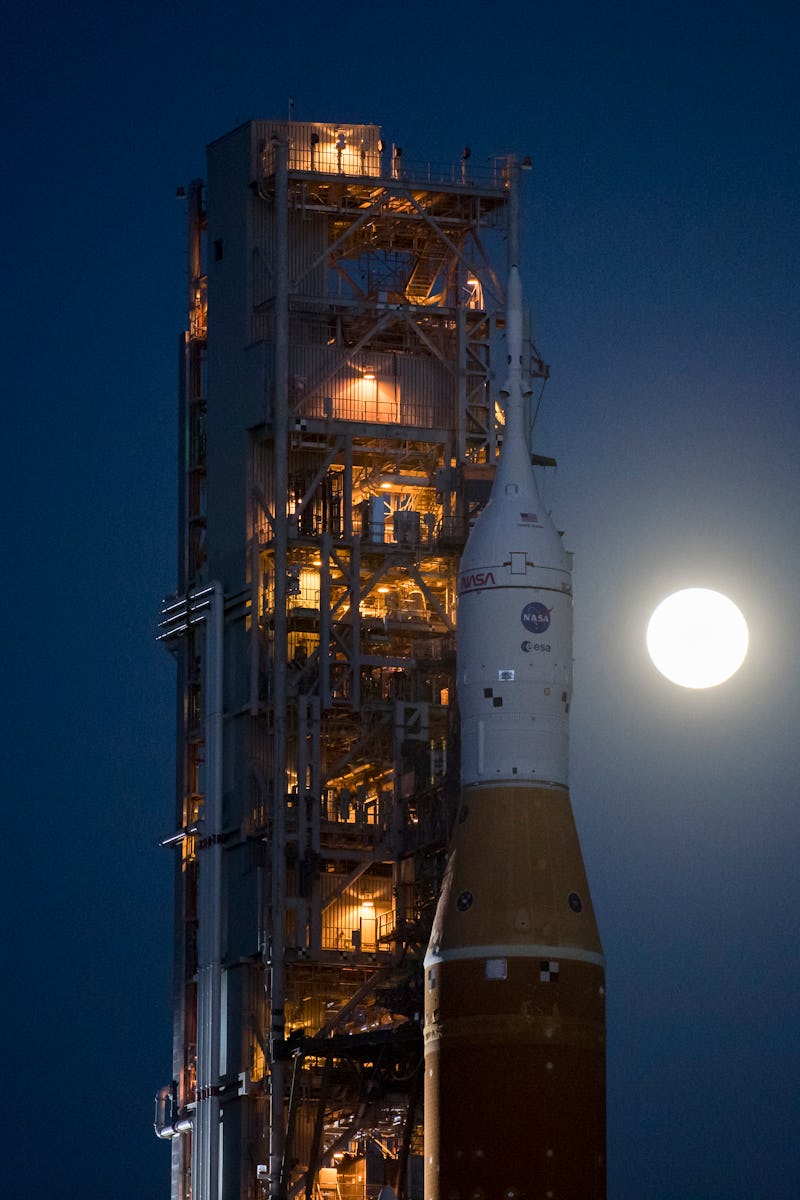
NASA
“From this sacred and historical place, humanity will soon embark on a new era of exploration.”
Behold! Colossal NASA SLS Moon rocket revealed in full for the first time
NASA rolled out the rocket that will power its Artemis missions, giving the public a glimpse at the sheer scale of the agency's ambitious space launch vehicle.
by Mike BrownNASA’s biggest dreams may soon come true, thanks to its biggest ever rocket.
On Thursday, March 17, the agency rolled out the under-development Space Launch System rocket fully stacked with the Orion spacecraft for the first time. The demonstration took place at the Kennedy Space Center in Florida late in the evening, allowing fans to both see the rocket in all its glory during the daylight and later bathed in moonlight.
The initial configuration is a sight to behold — this is the first time anyone has seen the rocket fully stacked in the open air. The entire spacecraft is approximately 100 meters tall — taller than the Statue of Liberty.
“From this sacred and historical place, humanity will soon embark on a new era of exploration,” NASA administrator Bill Nelson says in a statement. “Artemis I will demonstrate NASA’s commitment and capacity to extend humanity’s presence on the Moon – and beyond.”
The SLS: First full looks
The rocket is designed to support some of NASA’s most ambitious missions yet. This particular rocket will eventually launch Artemis I. Part of the Artemis program, a successor to the Apollo missions, Artemis I is slated to launch sometime this summer and involves sending an uncrewed Orion spacecraft 40,000 miles past the Moon to demonstrate the spacecraft’s capabilities.
If Artemis I succeeds, then the subsequent Artemis II mission will send humans in the spacecraft around the Moon, while Artemis III will see humans finally return to the Moon’s surface for the first time since 1972 (Artemis III will also rely on SpaceX’s megarocket, the Starship).
To propel Artemis I into space, the SLS needs a lot of power — and it has it. The SLS Block 1 configuration offers 8.8 million pounds of thrust at launch, around 15 percent more than the Saturn V rocket that remains the world’s most powerful rocket to ever fly.
Artemis I rocket rolls out to the launch pad.
The rocket is currently moving from High Bay 3 at the Vehicle Assembly Building out to Launch Complex 39B. Although the rocket is only traveling four miles, the crawler moves at a top speed of 0.82 mph. The crawler stopped for a brief period to adjust the crew access arm.
Artemis I on the early Friday morning.
Once at the launchpad, the team will complete the wet dress rehearsal — this will proceed throughout the month of March and into April. During the test, NASA will load over 700,000 gallons of cryogenic propellant into the rocket’s tanks, like liquid hydrogen and oxygen. They will run through the expected phases of the countdown, including weather checks.
Ultimately, this is just a part of a battery of tests the SLS will have to undergo before launch.
“Rolling out of the Vehicle Assembly Building is an iconic moment for this rocket and spacecraft, and this is a key milestone for NASA,” says Tom Whitmeyer in a statement. Whitmeyere is the deputy associate administrator for Common Exploration Systems Development at NASA Headquarters in Washington.
“Now at the pad for the first time, we will use the integrated systems to practice the launch countdown and load the rocket with the propellants it needs to send Orion on a lunar journey in preparation for launch.”
NASA's rocket shimmers in the water reflections.
They will then run the countdown clock. The clock will stop just before the engines would ignite, restart the clock, stop it 10 seconds before liftoff, and drain the propellants to simulate canceling a launch.
The Space Launch System with Orion capsule stands tall on Thursday evening.
What’s next for the SLS?
Once the rocket has completed its wet dress rehearsal, it will roll back to the Vehicle Assembly Building. Teams at the building will complete post-rehearsal checks, before the pair roll back to the launch pad around one week ahead of the final launch. The data from these tests will help the agency determine a more specific final launch date.
The Artemis I mission is scheduled to launch sometime in May. That will pave the way for Artemis II in 2024, before Artemis III returns humans to the Moon’s surface in 2025.
Of course, these dates are all preliminary. NASA’s program has been criticized for its high budget and repeated delays, especially compared to the SpaceX Starship program that could cost 2,000 times less per flight thanks to its reusable design. The SLS is expected to cost $4.1 billion per launch.
NASA also needs the Starship to be a success — it’s using a version of the ship to transport the humans to the Moon’s surface with Artemis III.
Update 03/18 1 p.m. Eastern time: An earlier version of this story claimed the Starship could cost 200 times less per flight. It has since been corrected.